Application on the theme "Birds"
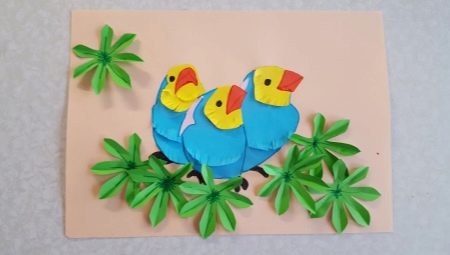
To make a bird craft, you can use paper, natural material, papier-mâché dough, and more. Crafts on this topic are especially in demand in the fall, and if you don't have your own ideas, you can always spy on ready-made options. And there, having slightly altered them for yourself, get a job worthy of the audience's attention. At school and kindergarten competitions, this is the most important thing.

How to make paper applique?
There are several options here, and each is good: you need to look at the child's age, opportunities, willingness to repeat the technological plan.
Here are some ideas the kids can replicate themselves (with a little help from adults).
- "The birds have arrived." This work will be relevant sooner in the spring. It is done as simply as possible: the cardboard is taken as a background (you can use blue or green), stripes of birch trees are cut out of white paper. Stripes are put on them with a black felt-tip pen. In several places, leaves are fixed on birches. On each tree there is a birdhouse made of printed paper, and next to it is a rounded bird. Well, the sun is in the corner. Birds can sit in a nest instead of a house.
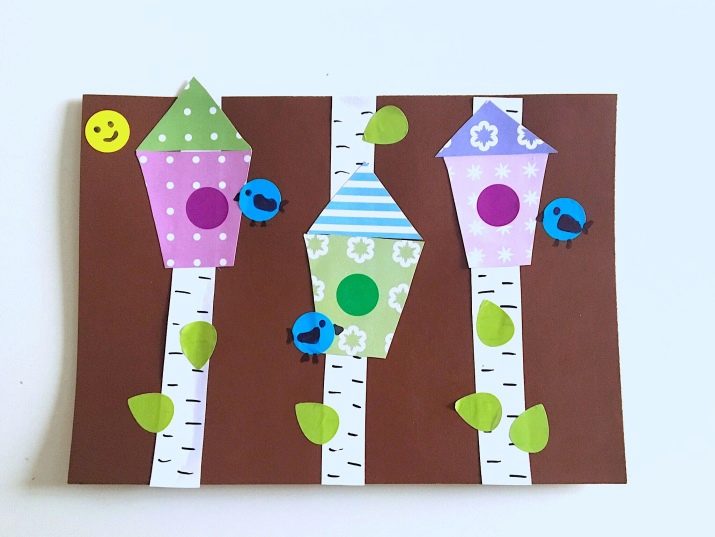
- "Owls on a branch." The work is much more difficult, but if the child knows what a mandala is and is passionate about such coloring, these owls will not seem too hard work for him to repeat. The hardest part is the eyes, but first you can draw the pattern with a pencil.

- "Traveling mood"... It's an autumn landscape, with birds flying south in the distance. It is also convenient to use printed paper that forms the foliage pattern on the trees. A child in 1-2 grade will cope with the work.

- "Feeder and birdie"... If the child is still very young, he is 3 years old, you can make such a composition.He will only paint. But due to the volumetric details, a quite interesting application is obtained.

- "Bird's Dining Room". A feeder is made of corrugated cardboard, the birds themselves are cut out of colored paper. Branches can be drawn, just like snow. However, snow can be made initially by spraying (using an old toothbrush and ruler).

- "New Year's Penguins". If an exhibition / competition is in winter, then where is it without penguins. They are cut out of colored paper (in fact, only orange will be colored). But the beauty of this applique is that it uses a rainbow background. And this is already done in advance - with watercolors or gouache.

- "Singing Swallows". These are the swallows of stripes sitting on the wires, also subject to children's hands. For the applique, you need a blue cardboard background and thick thread.

If just paper does not seem to be the most interesting material for working at an exhibition, there are more options.
Stages of making leaf crafts
The way birds fly to warmer regions can be depicted in different ways. If it's autumn, it is logical that these will be autumn natural materials. For example, dried leaves. This work is designed for preschoolers.
What you need:
-
any dry autumn leaves, colors from yellow to red, green are also possible;
-
a sheet of cardboard - preferably blue;
-
PVA glue;
-
safety scissors;
-
a piece of plasticine.

Consider step by step manufacturing.
-
Blue cardboard is taken as the basis, since this is the sky. Today on sale you can find different samples of cardboard, including those with "special effects" - metallized inserts, prints, velvet surface. Such cardboard can also be used.

- The bird itself will be placed in the center of the picture; for a child, this place can be marked with a pencil. To start with the body - a leaf is taken, dense, without defects, green, close to an oval shape. It is glued to cardboard with PVA glue. The child uses a glue brush. Pasted - smoothed. You can smooth it not with your hands, but with a soft, clean cloth.

- A beak is cut from a leaf of a different color according to the sample. A burgundy or red leaf is more suitable for this purpose. On the bird's head, you can make a crest in the color of the beak or another color.

- In the sample, an undeveloped acorn was used as an eye, but not everyone can find one, so it can be replaced with a plasticine circle. Alternatively, peppercorns are sometimes used.

- The wings of the bird will be multi-layered. To do this, cut the maple leaf in half. Both halves are fixed on sides different from the body.

- Above there will be the same maple leaves, cut into pieces, only different in color and size.

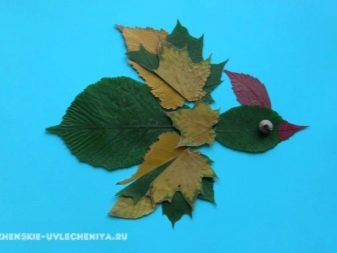
- To get a voluminous tail, you need to bend the leaves (in this case, plum leaves) with a tube, and put the junction on glue. Wait until the glue dries, and only then proceed to fixing the tail.

- It remains to cut out a couple of clouds and the sun from ordinary colored paper, complementing the picture with them.
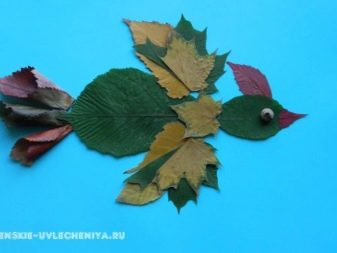

In order for the leaves to lie flat on the surface of the applique, they must be dried - you can iron them with an iron. And also dehydrated leaves are used, which are stored in the book.
Examples of other similar applications:
-
simple parrot - minimalistic works are often very expressive;

- such cockerel try to fold it again, but there is something to tinker with;

- whole composition with birds flying away, and materials - you find under your feet;
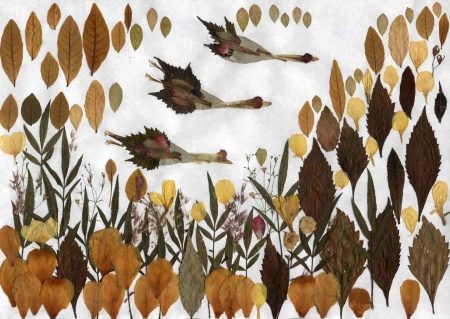
- such pictures are loved by kids, funny and uncomplicated stories;

- another one parrot version - only on the perch.

You can even make a triptych: 3 small appliqués on a bird theme. It turns out original.
What other materials can you make?
If you want the work to be more voluminous, and not lose its colorfulness and expressiveness, you can use plasticine. It is interesting to work with him for kids. True, children 3-4 years old still find it difficult to cope with plasticine application, but you can do it together with adults.Primary school children and those who have already crossed the border of high school are very fond of plasticineography.
Here are examples of plasticine bird paintings.
-
Such bright owls on a branch are a classic example of working in the technique of plasticineography.... They are depicted against a night background, because it is at this time that the birds go hunting. The tree is interestingly made: it consists of plasticine flagella. In order to obtain such even flagella, you can use special devices. Or you can take an ordinary plastic syringe (without a needle) and run soft plasticine through it.

- Owls on a tree look cute in this work, which is interesting for its round base. By the way, if you want to draw attention to the craft, you need to move away from rectangular bases, take something else, as in this work.

- Hen made with a lot of small details. The color transitions are almost perfect. But the background is also impressive: not just a monochrome surface, but a fragment of a beautiful landscape.

- And here it is exotic birds - finished plasticine paintings are sometimes varnished. So the craft will last longer.

- This work is simpler, at the core - plasticine flagella. The background can be replaced with more interesting ones, for example, printed cardboard or more colorful design paper.
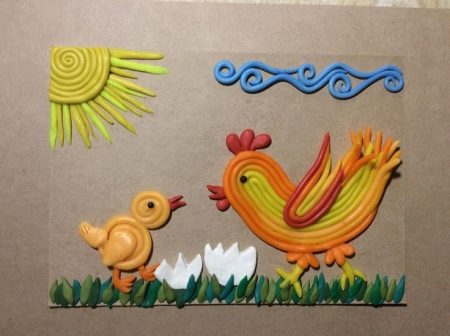
However, not only plasticine will help to originally depict birds in applications. For example, you can perfectly show wintering birds using felt. Bullfinches are especially bright, tactilely pleasant. You can also use corrugated paper to make an applique with backyard birds. If you roll up its fragments into small balls, they will become mosaic elements.

How beautifully birds sing in spring can also be shown with the help of an applique.
They use seeds for this, as well as cereals - they are suitable for a competition of works from natural materials. Buttons, beads, beads, pistachio shells, cork circles, plastic caps can also be used to make creative children's applications.
Happy experiments!
Application on the theme "Migratory birds" in the video below.








